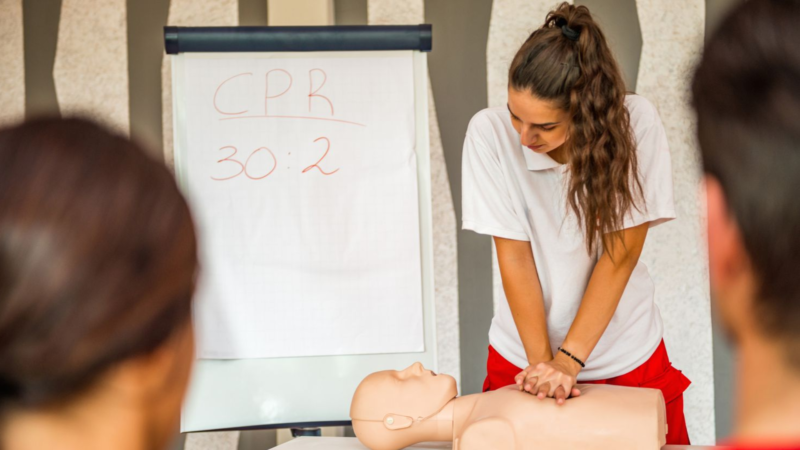When faced with a medical emergency, the steps taken in response can be critical. Therefore, anyone involved in first aid or safety personnel needs to prepare for these situations by learning and understanding the common causes of injury and illness and the associated treatments.
Did you know that first aid should be your number one priority in an emergency?

Knowing the necessary steps to take to perform first aid can make a huge difference. Whether it is knowing what to do in an accident or how to respond when someone has fainted, having this knowledge is essential and could even save lives!
Being well-informed on the essentials of first aid means you will be able to provide immediate help until professional assistance arrives. You will have peace of mind and feel empowered by being prepared for any unexpected situation that may arise around you or with your loved ones.
Check out these essential first aid steps that you should know
What are the first aid scenarios you should know about?
1. Bleeding
When responding to serious bleeding, the immediate goal is to control the bleeding and then take steps to provide further medical attention. You should use a clean, dry cloth to apply pressure directly onto the wound and elevate the injury if possible.
2. Burns
If someone has suffered a burn, immediately cool the area with cold water or a damp cloth. Cover the burned area with a clean, dry cloth to protect it from further injury.
3. Choking
If someone is choking, try to perform abdominal thrusts (also known as the Heimlich maneuver) to dislodge the object blocking the airway. If this doesn’t work, call for help right away and perform CPR if needed.
4. Fractures
If a fracture is suspected, immobilize the injury with a splint and call for help immediately. Soak up any excess blood from the area with a clean cloth or towel and elevate the injured limb if possible to reduce swelling.
5. Heart Attacks
If someone around you shows signs of a heart attack, call 911 immediately and start CPR if you are trained to do so. If an AED is available, use it to deliver a shock to the victim before starting chest compressions.
These are just a few of the many scenarios that might arise in an emergency. By understanding the basics of first aid and being prepared for any unexpected events, you can help save lives and ensure a better outcome for those involved. Remember to always stay calm, keep your cool and act quickly.
Where to get First aid Training

It is important to get proper first aid training from a certified instructor. Remember that knowledge is power and knowing how to react in an emergency can be the difference between life and death.
- The Red Cross
- Local hospitals
These are both great places to start if you’re looking for resources and courses on emergency preparedness. You should also ask your healthcare provider about any classes they may offer.
First aid Measures and Steps to Take
First aid for choking
If someone is choking, it means that their airway is blocked and they are having difficulty breathing. First aid for choking involves using one’s hands to perform the Heimlich maneuver, which is a series of abdominal thrusts that can dislodge the object and clear the airway.
What to do:
Step 1: Stand behind the person who is choking.
Step 2: Wrap your arms around their waist and make a fist with one hand.
Step 3: Place your other hand flat on top of the first, and press hard into the abdomen just above the belly button.
Step 4: Perform five abdominal thrusts until the object is expelled or they can breathe again.
First aid for bleeding
If someone is bleeding, it means that they have an injury that is causing blood to escape from their body. First aid for bleeding involves using direct pressure to apply a bandage to the wound to stop the bleeding.
What to do:
Step 1: Identify the source of the bleeding.
Step 2: Apply direct pressure to the wound with a clean cloth or bandage.
Step 3: If possible, elevate the injured area above the heart level to reduce the blood flow.
Step 4: Continue applying pressure and seek medical attention if necessary.
First aid for burns
If someone has a burn, it means that their skin has been damaged by heat, chemicals, or electricity. First aid for burns involves running cool water over the area for several minutes and then applying a sterile bandage.
What to do:
Step 1: Immediately cool the burn with cold water for at least 20 minutes.
Step 2: Remove any jewelry or clothing from the affected area to prevent further injury.
Step 3: Gently pat dry, and then cover it with a clean, sterile bandage.
Step 4: Seek medical attention if necessary.
First aid for sprains and strains
If someone has a sprain, it means that they have stretched or torn a ligament. A strain occurs when a muscle or tendon is stretched or torn. First aid for sprains and strains involves immobilizing the area with a splint or sling and then applying ice to reduce swelling.
What to do:
Step 1: Immobilize the affected area with a splint or sling.
Step 2: Reduce swelling with ice by applying it for 15 minutes at a time, several times a day.
Step 3: Elevate the injured area above the heart level to further reduce swelling.
Step 4: Seek medical attention if necessary.
5 Benefits of First aid training

- One of the primary benefits of first aid training is that it can help to reduce the number of injuries that occur. This is because people who have been trained in first aid are more likely to be able to identify potential hazards and take steps to avoid them, thus resulting in fewer injuries.
- Another benefit of first aid training is that it can help to reduce the severity of injuries that do occur. This is because people who have been trained in first aid are more likely to be able to provide appropriate care and minimize the amount of damage done.
- Improved survival rates: first-aid training can also improve survival rates for people who suffer from a serious injury or illness. This is because those who have been trained in first aid are more likely to be able to provide life-saving care until medical assistance arrives.
- Another benefit of first aid training is that it can provide individuals with greater peace of mind. This is because, by knowing how to properly respond in an emergency, one can help to ease anxiety and stress.
- Enhanced work performance: first aid training can also enhance work performance for both individuals and organizations as a whole. This is because people who have been trained in first aid are more likely than those who have not taken action in an emergency situation, which can help to prevent accidents and injuries from occurring.
Tip for First aid measures

- Assess the situation: when you come across an accident, it is important to first assess the situation before taking any action. This will help you determine whether or not you are able to provide assistance.
- Check for breathing: if the person is not breathing, it is important to begin CPR immediately. CPR can be done by anyone, and it does not need any special training. Place your hands in the center of the person’s chest and press down hard and fast at a rate of 100 times per minute.
- Stop the bleeding: if the person is bleeding, it is important to try to stop it. Apply direct pressure to the wound with a clean cloth or bandage. If the bleeding is severe, do not remove the cloth or bandage, as this could make it worse.
- Call 911 if the situation is serious. Wait for professional help to arrive; do not try to move the person unless they are in danger of further injury, such as if they are lying in the middle of a busy road.
By following these basic steps and being aware of the benefits of first aid training, one can help to ensure that they are better prepared in case of an emergency. With proper knowledge and preparation, one can provide life-saving care when it is needed most.
Frequently Asked Questions about First aid Measures
Q: What should I do if I come across an accident?
A: First, assess the situation and determine whether or not you are able to provide assistance. If it is safe to do so, check for breathing and apply direct pressure to any wounds. If the situation is serious, call 911, and wait for professional help to arrive.
Q: How do I perform CPR?
A: Place your hands in the center of the person’s chest and push down hard and fast at a rate of 100 times per minute. It is important to continue until help arrives or until the person begins breathing again.
Q: What should I do if someone has an injury?
A: Immobilize the injured area with a splint or sling to prevent further damage. If the person is bleeding, apply direct pressure to the wound with a clean cloth or bandage; do not remove the cloth or bandage, as this could make the bleeding worse. If necessary, call 911.
Conclusion
First aid training is an important skill that everyone should learn. It can save lives and help ensure better outcomes for those who suffer from an injury or illness. With the right knowledge and preparation, anyone can be equipped to handle an emergency situation. Always assess the situation before taking action and remember to call 911 if necessary. It could make all the difference in a life-or-death situation.
By understanding the basics of first aid and being prepared for any unexpected events, you can provide immediate help until professional assistance arrives. We hope this article has been helpful in giving you an overview of first-aid measures and how to respond in emergency situations. Be sure to seek additional training if necessary and remain calm when helping others in need.
Together, we can all strive to make a positive impact on our community by ensuring that everyone is prepared for any emergencies.









